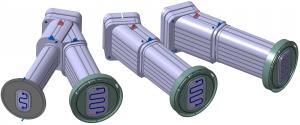Korean contract advances neutral beam ports
26 Aug 2013
-
Ji-Min Song, Korean Domestic Agency
The vacuum vessel's neutral beam ports are composed of a connecting duct, port extension, and port stub extension. The Korean contract signed in July covers the in-wall shielding that will be assembled inside the port's double shell.
The Korean Domestic Agency signed an important contract in July for the fabrication of neutral beam port in-wall shielding with Korean supplier Hyundai Heavy Industries Co., LTD (HHI). Through this contract, installation of the in-wall shielding into the port stub extensions will begin in mid-2015 with fabrication completed by early 2016. Hyundai Heavy Industries is also manufacturing two sectors of ITER vacuum vessel as contractor to the Korean Domestic Agency, as well as seventeen equatorial ports and the nine lower ports
The vacuum vessel's neutral beam ports are composed of a connecting duct, port extension, and port stub extension. The spaces between the inner and outer shells of the port extension and port stub extension are filled with preassembled blocks called in-wall shielding. The main purpose of in-wall shielding is to provide neutron shielding for the superconducting magnets, the thermal shield and the cryostat.
In order to provide effective neutron shielding capability with the cooling water, 40-millimetre-thick flat plates (steel type 304B4) are used in almost all areas of the volume between port shells.
In-wall shielding is composed of shield plates, upper/lower brackets and bolt/nut/washers. Pre-assembled 368 in-wall shielding blocks will be assembled into the neutral beam port extension and port stub extension during port fabrication, while 160 field joint in-wall shielding blocks will be assembled after field joint welding on the ITER site. The total net weight of all neutral beam in-wall shielding approximates 100 tonnes.
Ki-jung Jung, Director-General of the Korean Domestic Agency, commented during the signature: "ITER Korea takes very seriously the demands of the vacuum vessel schedule and quality requirements by ITER."


